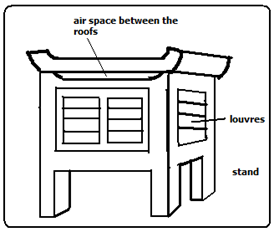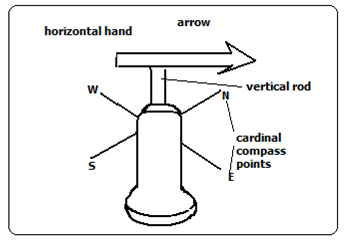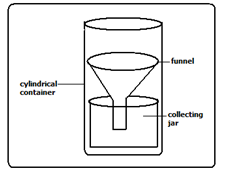
Weather
Weather is the daily atmospheric conditions of a place at a particular time.
Elements Of Weather
- Temperature
- Measure or degree of hotness or coldness of a place
- Humidity
- The amount of water vapour or moisture in the atmosphere
- Precipitation
- All forms of moisture which fall from the atmosphere to the earth’s surface
- Rainfall is a form of precipitation formed from clouds that in form of water droplets
- Atmospheric pressure
- Wind
- Moving air on the surface of the earth
- Sunshine
- Direct rays of sunlight on the surface of the earth
- Cloud cover
- Mass of tiny droplets of water or ice formed through condensation
Analysis and interpretation of weather conditions
Diurnal/daily Temperature range
-Difference between the maximum and minimum temperature for any one day.
Mean Daily Temperature
-Average of the maximum and the minimum daily temperatures.
Mean Monthly temperature
-Sum of mean daily temperatures in a month divided by the number of days in that month.
Mean Monthly minimum Temperature
-Sum of daily minimum temperatures divided by the number of days in that month.
Mean Monthly Maximum Temperature
-Sum of daily maximum temperatures divided by the number of days in that month.
Mean Annual Temperature
-Sum of mean monthly temperatures divided by 12.
Mean Annual Temperature Range
-Difference between the highest and the lowest mean monthly temperatures in a year.
Monthly Rainfall Total
-Sum of rainfall recorded in a month.
Annual Rainfall Total
-Sum of monthly rainfall totals for 12 months.
Mean Monthly Rainfall
-Sum of rainfall totals for a particular month over several years divided by the number of the years of observation.
Mean Annual Rainfall
-Sum of mean monthly rainfall for 12 months of the year.
Factors To Consider When Siting A Weather Station
Weather Station
- A place where observation, measuring and recording of weather elements is done
Factors to Be Taken Into Account When Sitting a Weather Station
- Open space
- An open place where there is little obstruction of weather elements.
- Accessible place
- Accessible place so that recording can be done easily.
- Gently sloping land
- A fairly level or gently sloping ground (5◦) so that it’s easy to position weather instruments.
- Security
- The place should have security
- The place should provide a wide view of the surrounding landscape and the sky.
- The site should be free from flooding.
Constructing Selected Instruments For Measuring Elements Of Weather
Instruments for Measuring Elements of Weather
- Thermometer- measures temperature
- Hygrometer- measures humidity
- Rain gauge-measures rainfall
- Barometer-measures air pressure
- Sunshine recorder-measures sunshine duration and intensity
- Wind vane –measures wind direction
- Anemometer-measures wind speed
- Constructing a wind stock
PUPIL’S ACTIVITY
PAGE 52
Materials needed- A paper cup
- Clay and plasticine
- A pin
- Drinking straw
- Marker pen
- A white circular cardboard
- Square and triangular paper cuttings
- A pencil with a rubber head
- Constructing a rain gauge
PUPIL’S ACTIVITY
PAGE 53
Materials needed- A 2-litre plastic bottle
- Ruler
- A ballpoint pen
- Masking tape
- A scalpel or pair of scissors
- Constructing a Windsock
PUPIL’S ACTIVITY
PAGE 53-54
Materials needed- Cylindrical bag
- String
- A scalpel
- Water paints
- An empty plastic fat/magarine tin
- Masking tape or cellotape
- A pole with a pointed end
- Painting brushes or chewed sticks
Significance of weather to human
- Helps us to be aware of natural calamities related to weather before they occur so as to take precautionary measures.
- Guiding tourists on when to visit national parks.
- Helps farmers to plan their activities such as planting, harvesting, etc.
- Ensures air and water transport is carried out safely.
- Helps sporting people to plan their training and competition schedules.
- Helps people to plan many other activities such as mining, electricity generation, holiday events, etc.
- Helps fishing communities to plan their activities
Historical Information
Sources of historical information in the society
- Monuments
- Caves
- Historical pictures
- Folk songs
- Old coins
- Recorded folk stories
- Archaeological sites
- Textbooks
- Articles
- Myths
- Artefacts,
- Fossils
Primary and secondary sources of information
Primary source is historical information that are created during the time period studied or were created at a later age by participant in even being practised
Secondary source is historical information that interprets or analyses a historical phenomenon
| Primary sources of historical information | Secondary sources of historical information |
Ways of preserving historical information
Significance of historical information in providing evidence of past accounts
| Sources of historical information | Significance of sources of information | How did it provide evidence of past accounts |
| Primary source | Provide cultural values of the society | They are preserved in museums and cultural centres for viewing |
| Secondary Sources | Provide knowledge to students of history | They are stocked in libraries and archives |
Download Weather - Grade 7 Social Studies Revision Notes.
Tap Here to Download for 30/-
Get on WhatsApp for 30/-
Why download?
- ✔ To read offline at any time.
- ✔ To Print at your convenience
- ✔ Share Easily with Friends / Students





